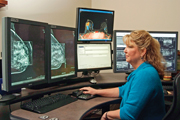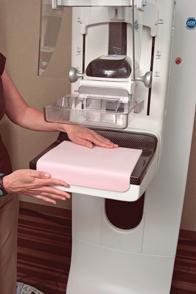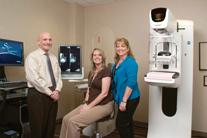
The physicians and staff at John C. Lincoln were pleased by the ease of the transition to tomosynthesis. Left to right: Michael Alpern, M.D. Sherry Gage, Director Linda Greer, M.D.
John C. Lincoln Health Network, a Phoenix-based health system that includes two hospitals and two dozen physician practices, is setting a new standard for quality breast care. In addition to being one of Arizona’s first truly comprehensive breast centers, the John C. Lincoln Breast Health and Research Center is the first in the state – and only the second in the nation – to offer 3D breast tomosynthesis.
Tomosynthesis, which enables 3D imaging of the breast, was approved by the FDA in February 2011. Thanks to careful planning, John C. Lincoln was poised to adopt the technology as soon as it became available and began offering it to patients in April 2011.
“When the breast center opened in 2009, we knew incorporating tomosynthesis would be a priority,” says Breast Center Director Sherry Gage. “So everything was designed with that long-term goal in mind,” including the purchase of a Hologic Selenia Dimensions digital mammography system and Hologic SecurView workstations.
Commitment to Patient Care
With a commitment to offering the best in patient care, the John C. Lincoln Breast Health and Research Center viewed tomosynthesis as an essential tool for breast imaging. A tomosynthesis scan acquires a series of low-dose images that can be viewed as a 3D reconstruction of the breast, enabling radiologists to identify and characterize individual structures without the confusion of overlapping tissue. The center’s experience shows improved cancer detection and a reduction in unnecessary recalls.
“This is absolutely amazing technology because it enables us to clearly see some cancers that are not visible on conventional 2D mammography. As a result, we’re able to detect even the tiniest cancers at the earliest stages,” says radiologist Linda Greer, M.D. “We’re so excited to have this improved technology available to our patients.”
Soon after the system became operational, radiologists at John C. Lincoln started detecting cancers that weren’t visible with conventional mammography. “In just the month that we’ve had it, I’ve seen four or five cancers that I honestly would like to think that I would have found on the original mammogram, but it was without a doubt present when we did the 3D imaging,” Greer said.
In addition, approximately five percent of patients who would have been called back for additional views if it weren’t for 3D imaging were spared the anxiety of unnecessary recalls.
For some patients at John C. Lincoln, the benefit of tomosynthesis is simply peace of mind. A woman with extremely dense breasts had been considering a bilateral mastectomy due to years of uncertainty, but her tomosynthesis scan helped radiologists determine for the first time that there were absolutely no abnormalities. Another patient with dense breasts and a strong family history of breast cancer was found to have a large cyst that did not appear on any previous exams.
“The cyst was fairly large, and the image was absolutely gorgeous. It definitely wasn’t cancer but it was interesting to see something we’d never been able to see before,” says Dr. Greer.
The John C. Lincoln Breast Health and Research Center is currently using tomosynthesis for both screening and diagnostic mammography. It offers it primarily to patients who it believes will benefit most from the technology, including women with dense breasts, fibrocystic tissue or those who have ever been called back for additional views due to overlapping tissue.
Superior Technology That’s Easy to Use
From start to finish – including installation, obtaining FDA accreditation and training – physicians and staff at John C. Lincoln were pleasantly surprised by the ease of the transition to tomosynthesis. The center already had a Selenia Dimensions unit, so there was no need for additional hardware; a simple software installation, which took less than a day, was all that was required to upgrade its system with 3D imaging capabilities.
Within four days of submitting its application to the FDA, John C. Lincoln received approval to perform tomosynthesis scans. The training was seamless, thanks to the user-friendly machine.
Superior technology aside, ease-of-use is one of the main reasons Gage predicts tomosynthesis will eventually become the gold standard of breast imaging.
“I’m very impressed with tomosynthesis. A technology may be state-of-the-art, but if it’s difficult to use and impacts your workflow to the extent that physicians and technologists can’t do what they need to do, it’s not going to become the standard of care,” says Gage, who has overseen numerous technology installations at the breast center and noted that tomosynthesis was by far the easiest.
Maximizing Workflow to Accommodate Demand
Optimizing workflow has always been a priority at the John C. Lincoln Breast Health and Research Center, and workflow considerations played heavily into the original design of the breast center. An exam using tomosynthesis takes no more additional time than a 2D mammogram, which enables the center to maintain its standard of scheduling screening mammograms every 10 minutes. However, with only one of its three digital mammography machines configured for tomosynthesis and as many as half of an average day’s patients requiring 3D imaging, a slight workflow adjustment was required to accommodate the increased demand of patients.
Two technologists are now assigned to the room with the Selenia Dimensions system. While the first technologist is performing an exam, the second is doing a consultation with another patient in a different room. When the second technologist takes her patient in for the exam, the first begins a consultation with a new patient.
“We configured our workflow to maximize the use of the equipment with as little downtime as possible,” says Gage, who estimates they perform an average of 25 to 30 tomosynthesis exams per day. “All it took was a small adjustment, and we were back on track.”
A smooth workflow is important for future success, as the availability of tomosynthesis is clearly attracting more patients to the breast center. Although exact figures are not available, Gage says they are seeing a significant increase in new patients based on the number of exams being sent from outside facilities. The number has jumped to approximately 35 to 40 per day since the center started offering tomosynthesis, and women are coming from as far as Utah to receive a 3D exam.
“Many women are coming from other centers because they are called back for additional views year after year, and they want to have tomosynthesis to get rid of that uncertainty,” says Gage.
Fortunately, the John C. Lincoln Breast Health and Research Center was designed to manage as many as 150 exams per day, so there is plenty of capacity to accommodate the increased demand. In anticipation of a significant volume increase, Gage is already looking into upgrading another one of the center’s digital mammography units with tomosynthesis by the end of 2011.
Comfort Improves Patient Satisfaction
In addition to the latest imaging technology, women at John C. Lincoln also get to experience the benefits of the Hologic MammoPad breast cushion. The soft foam cushion is placed on the mammography detector to create a warmer, softer exam, and it improves both patient comfort and clinical results.
Though Gage is now a big proponent of the MammoPad cushion, she was initially opposed to the expenditure. She didn’t think a small piece of foam was worth the money. But once they started using it on patients, she saw how much women, particularly those who are fearful of pain, appreciated the feeling of warmth instead of a cold, hard detector.
“MammoPad really does provide an unbelievable comfort. I tell patients it’s like putting your breast on a mattress,” says Gage. “We’ve seen firsthand how addressing patient comfort improves compliance and keeps women coming back for their mammograms year after year.”
Technologists also noticed clinical benefits with the MammoPad cushion. The traction of the foam surface holds the breast in place, enabling the technologists to get more tissue and muscle in the image. Acquiring posterior muscle on a CC view was never a requirement, Gage says, but now it’s become standard with MammoPad breast cushion.
“I didn’t expect to see these kinds of clinical results. I don’t hire technologists who don’t have good positioning skills to begin with,” she says. “But there’s a difference between good positioning and excellent positioning.”
Truly Comprehensive Care
Customer service is as important at the John C. Lincoln Breast Health and Research Center as offering the latest technology, so the center was careful to ensure that advanced technology does not come at the expense of patient care. In particular, John C. Lincoln places a special emphasis on education – particularly when it comes to new technology like tomosynthesis.
“We don’t just want to offer our patients state-of-the-art technology – we also want to explain why we’re offering it. For patients who would benefit from 3D imaging, it’s a good opportunity for us to educate them,” says Gage. “Women are very happy if you take the time to explain this new technology, how it works and why it can benefit them.”
In fact, it is the emphasis on education that differentiates John C. Lincoln Breast Health and Research Center as a truly comprehensive breast center. Mammography is rarely the beginning or the end of the center’s involvement with a patient’s breast health.
“Technology is important, but you also need to educate patients to take control of their health,” Gage says. “We’re very big on education and walking the patient through the entire journey of breast cancer.”
The journey often begins with risk assessment, followed by mammography and, if necessary, ultrasound, breast MRI, breast biopsies, surgery, radiation oncology or reconstructive surgery – all accessible at the breast center. A patient care coordinator assists women at every step, including scheduling appointments and communicating with referring physicians. The state-of-the-art facility also features a full-service library with reference materials and brochures, as well as books that patients can take home.
It is this same dedication to service that sets John C. Lincoln Breast Health and Research Center apart from its competitors. Some facilities provide cutting-edge technology but overlook patient comfort. Others offer comfortable surroundings but sacrifice service. John C. Lincoln offers state-of-the-art technology in a comfortable setting with a focus on customer service and patient education – the whole package for quality breast care.
“For the last 80 years, this organization has been driven by a commitment to serving people with the highest quality care,” says Gage. “Tomosynthesis is simply the latest tool in our array of resources that makes sure our patients have the very best.”
The comments included in this publication are the opinions and personal stories of the individuals quoted and not necessarily those of Hologic. Hologic, Dimensions, MammoPad, SecurView and Selenia are trademarks and/or registered trademarks of Hologic Inc. and/or its subsidiaries in the United States and/or other countries.




 December 17, 2025
December 17, 2025 








